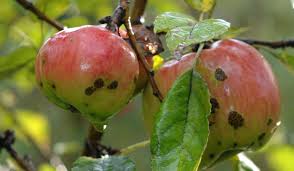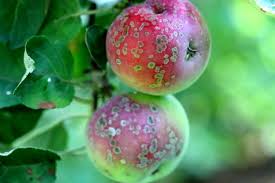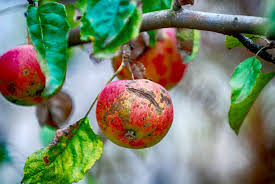Apple scab, scientifically known as Venturia inaequalis, is a common fungal disease that affects apple trees. This plant pathology is caused by a fungus belonging to the Venturia genus. Apple scab primarily targets apple trees, impacting both fruit production and overall tree health.
The fungus responsible for apple scab thrives in moderate to cool climates, with high humidity being a contributing factor to its spread. The disease manifests as dark, scaly lesions on leaves, fruit, and sometimes even young twigs. These lesions can adversely affect the aesthetic appeal of apples and compromise their market value.
One of the key features of apple scab is its ability to overwinter in infected leaves on the ground. This cycle perpetuates the disease, as spores are released in the spring, spreading to new growth and initiating the infection process once again. The fungus has a remarkable ability to adapt, making it challenging for apple growers to manage and control effectively.
Cultivar resistance, fungicide applications, and good orchard management practices are commonly employed to mitigate the impact of apple scab. Selecting apple varieties with natural resistance to the fungus can be an essential strategy in preventing widespread infections. Additionally, carefully timed fungicide treatments during the growing season can help reduce the severity of the disease.
Proper orchard hygiene, such as removing fallen leaves and pruning infected branches, plays a crucial role in preventing the overwintering of the fungus. These practices aim to break the disease cycle and limit the availability of infected plant material for the fungus to thrive.
Apple scab not only affects the visual appeal of the fruit but can also compromise the overall health and productivity of apple trees. We must recognize the importance of adopting integrated pest management strategies to address this fungal disease comprehensively.
However, Venturia inaequalis, commonly known as apple scab, poses a significant challenge to apple cultivation worldwide. The complex life cycle and adaptability of the fungus require a holistic approach to management, encompassing resistant cultivars, strategic fungicide applications, and meticulous orchard practices. Effectively tackling apple scab is essential for maintaining the vitality and economic viability of apple orchards, ensuring a bountiful harvest of high-quality fruit for consumers.
Read Also: Scale Insects: Description, Damages Caused, Control and Preventive Measures
Plants Affected by Apple Scab (Venturia inaequalis)

Apple scab primarily affects apple trees (Malus domestica). The fungus Venturia inaequalis, responsible for apple scab, targets various parts of the apple tree, including leaves, fruit, and occasionally young twigs. The disease is particularly detrimental to apple orchards, impacting both the visual appeal of the fruit and the overall health of the trees.
The manifestation of apple scab is evident in the form of dark, scaly lesions on the leaves and fruit. These lesions can compromise the quality of the apples, making them less appealing to consumers. The susceptibility of apple trees to this fungal disease underscores the importance of implementing effective management strategies to minimize its impact on orchard productivity.
Recognizing the host specificity of Venturia inaequalis is crucial for orchard management, as other plants are generally not affected by apple scab. While the fungus may have similarities with other Venturia species that impact different plants, apple scab is predominantly a concern for apple cultivators due to the susceptibility of apple trees to this particular fungal pathogen.
Damages Caused by Apple Scab

Apple scab, caused by the fungus Venturia inaequalis, inflicts various damages on apple trees, affecting both their appearance and overall health. The consequences of apple scab include:
1. Reduced Aesthetic Appeal: The most visible damage is the formation of dark, scaly lesions on leaves, fruit, and sometimes young twigs. These lesions diminish the visual appeal of the apples, making them less marketable and desirable to consumers.
2. Decreased Fruit Quality: Infected fruit often suffers from deformities, reduced size, and altered texture. The compromised quality of apples due to scab lesions can lead to lower market prices and economic losses for orchard owners.
3. Impaired Photosynthesis: The presence of scab lesions on leaves interferes with the process of photosynthesis, reducing the tree’s ability to produce energy and nutrients. This can result in stunted growth, weakened trees, and diminished overall orchard productivity.
4. Premature Leaf Drop: Severe infestations can lead to premature leaf drop, further exacerbating the negative impact on photosynthesis. Loss of leaves weakens the tree and hinders its ability to store energy for the following growing season.
5. Weakened Tree Vigor: Repeated infections over multiple growing seasons can lead to a decline in overall tree vigor. Weakened trees are more susceptible to other diseases, pests, and environmental stresses, potentially impacting the long-term sustainability of the orchard.
6. Fruit Yield Reduction: Apple scab can cause a significant reduction in fruit yield. The compromised health of the tree, coupled with the direct impact on fruit development, contributes to lower harvest quantities, affecting the economic viability of apple orchards.
7. Increased Management Costs: Orchards affected by apple scab often require increased management efforts and resources. Regular applications of fungicides, cultural practices such as pruning, and the removal of infected plant material contribute to higher production costs for growers.
Understanding the range of damages caused by apple scab emphasizes the importance of implementing effective management strategies. Proactive measures such as selecting resistant cultivars, practicing good orchard hygiene, and timely fungicide applications are essential to mitigate the economic and agricultural impacts of this fungal disease.
Read Also: Spider Mites: Description, Damages Caused, Control and Preventive Measures
Control and Preventive Measures

Effective control and preventive measures are crucial in managing apple scab caused by the fungus Venturia inaequalis. Here are key strategies to mitigate the impact of the disease:
1. Cultivar Selection: Opt for apple tree cultivars that exhibit resistance to apple scab. Resistant varieties can significantly reduce the likelihood and severity of infections, providing a natural defense against the fungus.
2. Fungicide Applications: Regularly apply fungicides during the growing season to protect apple trees from scab infections. Timely and properly scheduled fungicide treatments can help control the spread of the fungus and minimize the development of scab lesions on leaves and fruit.
3. Orchard Hygiene: Practice good orchard hygiene by removing fallen leaves and pruning infected branches. This reduces the availability of overwintering sites for the fungus, disrupting its life cycle and preventing the reoccurrence of infections in subsequent seasons.
4. Monitoring and Early Detection: Regularly monitor orchards for signs of apple scab, especially during the spring when the fungus releases spores. Early detection allows for prompt intervention, minimizing the potential for widespread infection.
5. Weather-Based Predictive Models: Utilize weather-based predictive models to anticipate favorable conditions for scab development. This information can aid in scheduling fungicide applications more accurately, optimizing their effectiveness.
6. Avoiding Wet Conditions: Since high humidity contributes to the spread of apple scab, implement practices that reduce moisture levels around the trees. These may include proper spacing between trees, providing adequate air circulation, and avoiding overhead irrigation.
7. Pruning: Adopt proper pruning techniques to improve air circulation within the canopy, promoting faster drying of leaves after rainfall. This reduces the favorable conditions for fungal growth and minimizes the risk of infection.
8. Mulching: Apply organic mulch around the base of apple trees to prevent soil splashing onto lower leaves. Soil splashing can carry scab spores to the foliage, initiating new infections.
9. Biological Controls: Explore the use of beneficial organisms, such as predatory mites and beneficial fungi, to naturally suppress scab populations. This approach is part of integrated pest management (IPM) strategies that aim to minimize reliance on chemical treatments.
10. Educational Programs: Implement educational programs for orchard workers to raise awareness of apple scab and the importance of implementing preventive measures. Well-informed orchard management practices contribute to the overall success of scab control efforts.
By integrating these control and preventive measures, apple growers can effectively manage apple scab, preserving the health and productivity of their orchards while minimizing the need for extensive chemical interventions.
Frequently Asked Questions (FAQs) About Apple Scab (Venturia inaequalis)
1. Q: What is apple scab, and what causes it?
A: Apple scab is a fungal disease caused by Venturia inaequalis. This pathogen infects apple trees, leading to the development of dark, scaly lesions on leaves, fruit, and occasionally young twigs.
2. Q: How does apple scab spread?
A: Apple scab spreads through spores released by the fungus. These spores are carried by wind or rain, initiating new infections during the growing season. Overwintering in fallen leaves contributes to the perpetuation of the disease.
3. Q: What are the signs of apple scab infection?
A: Signs include dark, scaly lesions on leaves, fruit, and sometimes young twigs. Infected leaves may prematurely drop, and fruit quality is compromised with deformities and reduced size.
4. Q: Can apple scab affect other fruit trees or plants?
A: While Venturia inaequalis primarily targets apple trees, other Venturia species can impact different plants. However, apple scab is generally not a concern for plants other than apples.
5. Q: How can I prevent apple scab in my orchard?
A: Prevention measures include selecting resistant cultivars, applying fungicides during the growing season, practicing good orchard hygiene (removing fallen leaves), and monitoring for early signs of infection.
6. Q: Are there natural methods to control apple scab?
A: Yes, adopting natural methods such as using beneficial organisms (predatory mites, beneficial fungi), proper pruning for air circulation, and mulching can contribute to apple scab control in an environmentally friendly way.
7. Q: When is the best time to apply fungicides for apple scab control?
A: Fungicides should be applied preventively before the growing season and during periods when environmental conditions are favorable for scab development, typically in the spring.
8. Q: Can apple scab be completely eradicated from an orchard?
A: Complete eradication is challenging, but effective management practices can significantly reduce the impact of apple scab. Combining cultural practices, resistant cultivars, and timely fungicide applications is key.
9. Q: How does weather impact the spread of apple scab?
A: Weather, especially high humidity and wet conditions, facilitates the spread of apple scab. Implementing control measures during periods of favorable weather is crucial for managing the disease.
10. Q: What is the economic impact of apple scab on orchards?
A: Apple scab can lead to economic losses due to reduced fruit quality, lower market prices, and increased management costs. It can also weaken overall orchard productivity and tree vigor over time.

